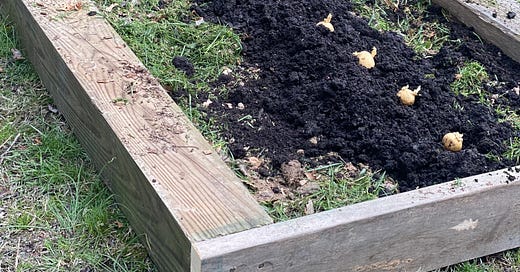We planted potatoes yesterday. The idea sprang up in the fertile ground between instinct and impulse.
Last fall, a neighbor marked for removal all the trees from the front half of his backyard. I talked with the tree service foreman, urging him to urge the owner to rethink. I couldn’t blame the man for wanting to introduce more light into the area. I could even justify his interest in eliminating the sweet gums that drop their spiked, Covid-shaped balls everywhere. I’d hoped, however, that he might at least spare the substantial red oak at the far corner of the space. Word had it he was reconsidering, but the crew ended up taking them all. Bearing witness to the splintering of that strong community made my heart hurt, but I tried to see possibilities in the added sun exposure that would befall my shade-ridden growing spaces come spring.
Right around the time the trees tumbled, my favorite farmer lost her beloved husband, followed by her beloved dog and her primary farm help. Then, she fell and broke her elbow. We’ve known each other for 25 years, worked together for 15 with me bartering services for food. I’ve always felt like I got the better end of that trade. Now, there was no way she was going to be able to continue farming at the same capacity, or at all, and ridiculous as it may seem, we both wondered how we’d manage to feed ourselves without the abundant fresh produce from her farm.
The pandemic wore on. Russia invaded Ukraine. Apocalyptic thinking took root in my amygdala, prompting rabbit hole dives on topics like food insecurity and nuclear strikes. Thoughts of those duck-and-cover drills of my youth resurfaced. What possible good did Cold War leaders think would come of teaching school children how to take shelter under a desk in the event of an atomic attack? As if we needed fertilizer for our anxiety!
Speaking of rabbit holes.
A few days ago, I discovered that a collection of petite, yellow spuds in my pantry had sprouted. Another time, I would have popped the shoots off into my compost bucket and found a way to use the potatoes in my next meal. But, these gave me pause. Unlike the withered tubers I occasionally unearth from my cupboard that remind me of my own body parts at this stage of life, these potatoes looked pubescent, firm, like the carefully managed seed potatoes I used when I was a farmer. Memories emerged.
For anyone who hasn’t had the thrill, digging a successful crop of potatoes is like winning a game. You’ve been paying attention, making the right moves. After two or three months of effort, you’re on and feeling lucky. You tuck the tips of your digging fork into the ground, just beyond the area where the new tubers might have developed. Using pressure from your foot on the metal tines, you sink the tool all the way in, then press the handle down toward the ground. With the fork acting as a lever, a mound of earth erupts and globes of starchy goodness spill out. BINGO! Look at that prize! You become a human backhoe, a tater-cavater, lifting, sifting, sorting, and feeling exceptionally pleased with whatever part you had to play in this small victory.
Unfortunately, my wins were unreliable. For all their identity as a staple food, raising marketable potatoes was not without headaches. An unchecked outbreak of voracious Colorado potato beetle larvae decimated the leafy top growth of an entire crop in 24 hours. Below ground, wireworms and root knot nematodes got into the contest, damaging my already limited yields. Potatoes also competed for space with other crops I wanted to plant.
They might still have been worth wrangling if not for the expectation that potatoes should be dirt cheap. I didn’t have enough space to overcome all the issues with sheer volume, so, as with squash, I eventually decided to let my market customers buy their potatoes from other farmers, freeing me up to home in on niche products like fava beans and diminutive Tom Thumb lettuces.
I haven’t grown potatoes for 20 years. But things being as they currently are, I couldn’t resist the insistence of those humble orbs in my pantry springing up in hopes of revival. Planting them directly in the ground was not an option. Our clay soils are like my childhood sleeping bag after a rainy campout – impossibly heavy and relentlessly soggy. We settled on the git ‘er done approach, tossing together a bottomless border using lumber already on hand.
The absence of proper dirt, coupled with our unwillingness to sink much time or money into this experiment, means the method currently in the works is unconventional. We’ve filled the new space with available materials, some shredded leaves, some grass clippings, a bag of old garden soil someone gave us, a sprinkle of chicken litter from a farmer up the road. Mostly, though, we’re using wood chips, stockpiled in our yard since last fall, from the trees that once lived next door.
The dandelions are blooming. Farming lore says that’s the right time to plant potatoes. It will be months before we’ll know if there is anything to harvest, but somehow, there is already a feeling of triumph.
~ Elizabeth








I have a chunk of purple sweet potato rooting and leafing in a jar on the windowsill at the moment. Can't wait to plant and see what happens!
Was just looking at a similar bag of potatoes n thinking abt throwing them in the ground as an experiment! Tater-cavatee… 🤣🤣😘❤️